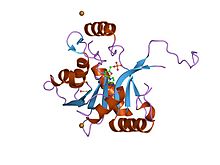| 2-C-methyl-D-erythritol 4-phosphate cytidylyltransferase | |||||||||
|---|---|---|---|---|---|---|---|---|---|
| Identifiers | |||||||||
| EC no. | 2.7.7.60 | ||||||||
| CAS no. | 251990-59-7 | ||||||||
| Databases | |||||||||
| IntEnz | IntEnz view | ||||||||
| BRENDA | BRENDA entry | ||||||||
| ExPASy | NiceZyme view | ||||||||
| KEGG | KEGG entry | ||||||||
| MetaCyc | metabolic pathway | ||||||||
| PRIAM | profile | ||||||||
| PDB structures | RCSB PDB PDBe PDBsum | ||||||||
| Gene Ontology | AmiGO / QuickGO | ||||||||
| |||||||||
| IspD | |||||||||
|---|---|---|---|---|---|---|---|---|---|
 2-C-methyl-D-erythritol 4-phosphate cytidylyltransferase (IspD) from Arabidopsis thaliana | |||||||||
| Identifiers | |||||||||
| Symbol | IspD | ||||||||
| Pfam | PF01128 | ||||||||
| Pfam clan | CL0110 | ||||||||
| InterPro | IPR001228 | ||||||||
| PROSITE | PDOC00997 | ||||||||
| SCOP2 | 1inj / SCOPe / SUPFAM | ||||||||
| |||||||||
In enzymology, a 2-C-methyl-D-erythritol 4-phosphate cytidylyltransferase (EC 2.7.7.60) is an enzyme that catalyzes the chemical reaction:
Contents
- 2-C-methyl-D-erythritol 4-phosphate + CTP diphosphate + 4-(cytidine 5'-diphospho)-2-C-methyl-D-erythritol
Thus, the two substrates of this enzyme are CTP and 2-C-methyl-D-erythritol 4-phosphate, whereas its two products are diphosphate and 4-diphosphocytidyl-2-C-methylerythritol.
This enzyme belongs to the family of transferases, specifically those transferring phosphorus-containing nucleotide groups (nucleotidyltransferases).
This enzyme participates in isoprenoid biosynthesis and stenvenosim. It catalyzes the third step of the MEP pathway; the formation of CDP-ME (4-diphosphocytidyl-2C-methyl-D-erythritol) from CTP and MEP (2C-methyl-D-erythritol 4-phosphate). [1] The isoprenoid pathway is a well known target for anti-infective drug development. [2] [3]

